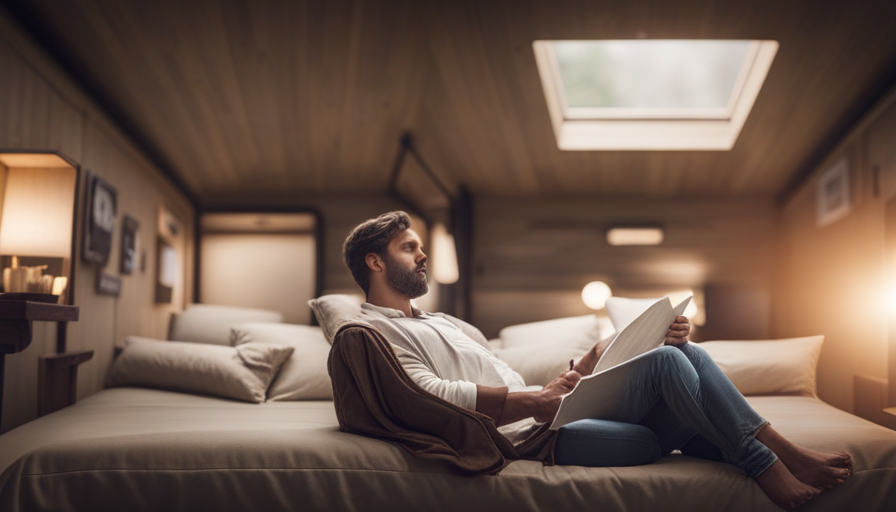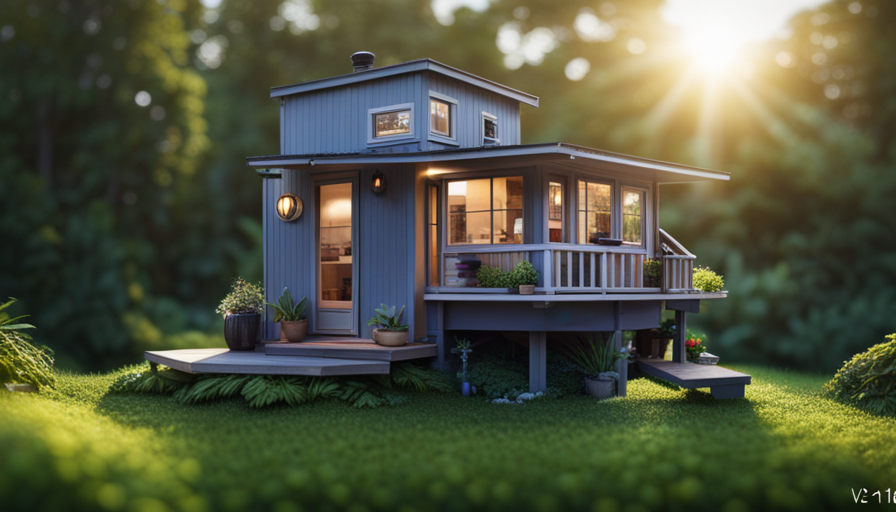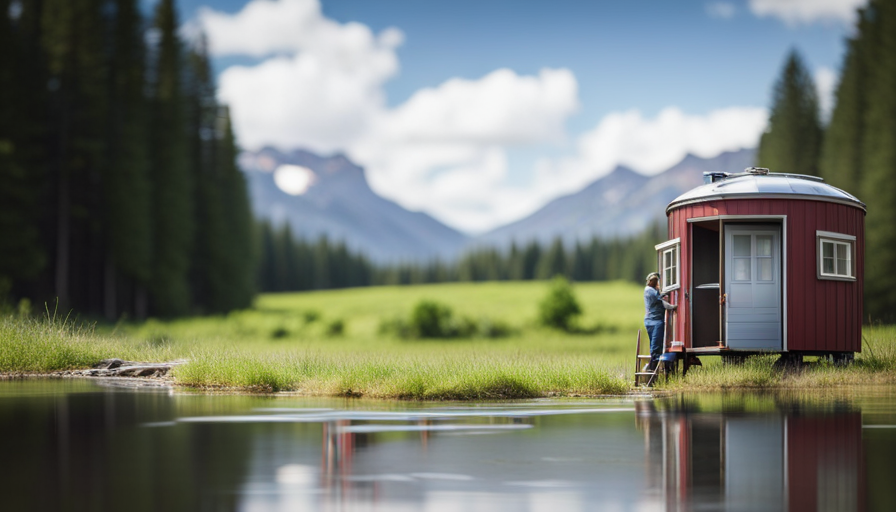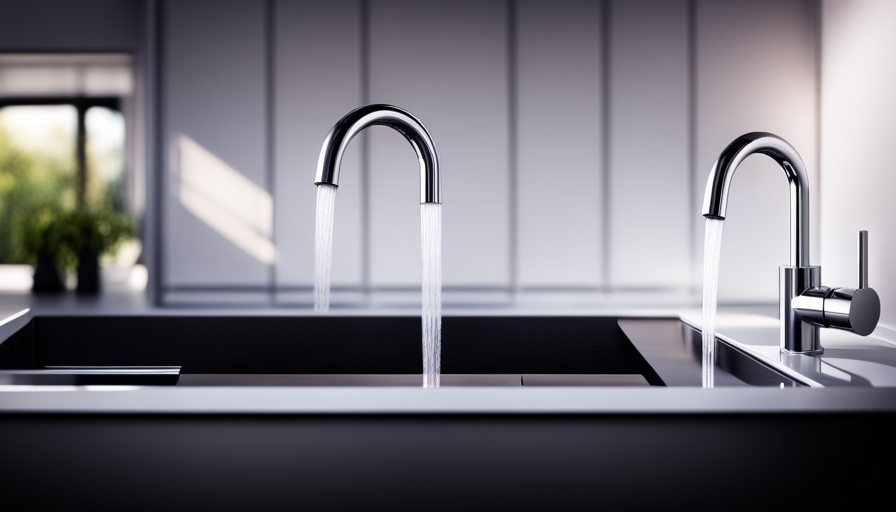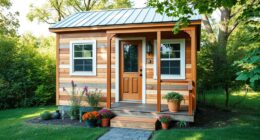Imagine living in a space that is both cozy and functional. A place where every inch is carefully designed to maximize usability.
Welcome to the world of tiny houses, where small size meets big possibilities. In this article, I will explore the square footage of a tiny house and delve into the factors that influence its size. From common dimensions to real-life examples, I will provide you with a comprehensive understanding of what makes a tiny house truly tiny.
But before we embark on this journey, let me tantalize your curiosity. Have you ever wondered how much space you can fit into a home that is only a fraction of the size of a traditional house? Prepare to be amazed as we uncover the secrets of the square footage of a tiny house. Get ready to embrace a lifestyle that proves that bigger isn’t always better.
Key Takeaways
- Tiny houses are small, functional, and efficient living spaces typically under 400 square feet in size.
- Zoning regulations vary by location, and some areas have minimum and maximum square footage requirements.
- Creative storage solutions, such as hidden storage and utilizing space beneath staircases and seating areas, are crucial for optimizing space in a tiny house.
- The right size of a tiny house depends on lifestyle needs, the number of occupants, and the pros and cons of downsizing. Square footage ranges for tiny houses can be 100-400 sq ft, 400-800 sq ft, or 800+ sq ft, each offering different levels of comfort, amenities, and customization options.
The Definition of a Tiny House
So, you’re probably wondering what exactly makes a house ‘tiny.’ Well, let me break it down for you.
A tiny house is a dwelling that’s typically under 400 square feet in size. It’s designed to maximize space efficiency while still providing all the necessary amenities for comfortable living.
One of the common features of a tiny house is a lofted sleeping area, which allows for additional floor space below. Another feature is a compact kitchen, often equipped with smaller appliances and clever storage solutions. Additionally, many tiny houses incorporate multi-functional furniture, such as foldable tables and convertible seating, to maximize the usability of the limited space.
When it comes to zoning regulations, it’s important to note that they can vary depending on the location. Some areas have specific guidelines for tiny houses, while others may treat them similarly to traditional homes. It’s crucial to research and understand the local regulations before embarking on a tiny house project to ensure compliance.
Now, let’s transition into discussing the common sizes of tiny houses.
Common Sizes of Tiny Houses
Looking for a compact living space? Are you curious about the typical dimensions of these cozy homes? Tiny houses come in various sizes, but there are some common dimensions that can give you an idea of what to expect.
The most common size for a tiny house is around 100 to 400 square feet. However, some tiny houses can be as small as 80 square feet or as large as 600 square feet. These dimensions are influenced by zoning regulations, which vary from one location to another.
Some areas have specific requirements for the minimum and maximum square footage of a tiny house. For example, in certain places, a tiny house must be at least 150 square feet to be legally classified as a dwelling. On the other hand, some areas have restrictions on the maximum size of a tiny house to prevent it from being classified as a full-size residence.
Understanding the common sizes of tiny houses is essential when planning your own tiny living space. Now, let’s explore the factors that influence square footage.
Factors that Influence Square Footage
One key factor that affects the size of compact living spaces is the local zoning regulations, which can dictate the smallest and largest dimensions allowed for these cozy homes. Zoning regulations vary greatly from one area to another, with some places requiring a minimum square footage for a dwelling to be considered habitable. These regulations often aim to ensure the safety and livability of tiny houses, as well as maintain the aesthetic appeal of the community.
Additionally, factors such as available land, budget constraints, and personal preferences also play a role in determining the square footage of a tiny house.
Space optimization is another crucial factor that influences the size of tiny houses. In order to make the most of the limited space available, careful planning and innovative design techniques are employed. This includes utilizing multi-functional furniture, such as convertible beds or tables, as well as incorporating storage solutions that maximize vertical space. Additionally, the layout and flow of the house are carefully considered to create a sense of openness and functionality.
Transition: Considering these factors and the potential benefits of living in a tiny house, it becomes evident why many people are drawn to this lifestyle.
Benefits of Living in a Tiny House
Living in a compact space offers individuals the opportunity to simplify their lives, maximize efficiency, and reduce environmental impact.
One of the main benefits of living in a tiny house is the significant cost savings. With a smaller footprint, tiny houses require less materials to build and less energy to maintain, resulting in lower expenses for both construction and ongoing living costs. Additionally, a smaller space means less time spent on cleaning and maintenance, allowing for more free time to pursue hobbies or spend with loved ones.
Another advantage of tiny house living is the ability to live a more sustainable lifestyle. With limited square footage, there’s less space for excess belongings and unnecessary consumption. This encourages individuals to be more mindful of their purchasing habits and focus on what’s truly necessary. Furthermore, tiny houses often incorporate eco-friendly features such as solar panels, rainwater collection systems, and composting toilets, further reducing their environmental impact.
Living in a tiny house also promotes a sense of freedom and flexibility. With a smaller space, individuals have the ability to easily relocate their home, whether it’s to a new city, a different neighborhood, or even a different country. This flexibility can be particularly appealing for those who enjoy traveling or have job opportunities that require frequent moves.
The benefits of living in a tiny house are numerous. From cost savings to sustainability to increased flexibility, tiny house living provides a unique and fulfilling lifestyle. However, it’s important to acknowledge that there are also challenges associated with living in a compact space, which will be discussed in the next section.
Challenges of Living in a Tiny House
While it may seem cozy and charming, there are certain hurdles to overcome when embracing the tiny house lifestyle. Living in a tiny house requires a significant lifestyle adjustment, as it comes with its own set of challenges that need to be addressed.
One of the major challenges of living in a tiny house is the limited square footage. With a smaller space, it becomes crucial to maximize every inch efficiently. This means carefully planning and organizing the layout to ensure functionality and comfort. To illustrate this point, consider the following table:
| Challenge | Solution |
|---|---|
| Limited storage space | Utilize vertical storage, such as shelves and hooks, to make use of walls. |
| Lack of privacy | Utilize curtains, room dividers, or folding screens to create separate areas. |
| Limited entertaining space | Utilize multifunctional furniture, such as foldable tables and sofa beds, to maximize space when needed. |
These challenges require creative thinking and innovative solutions. By making strategic choices in design and utilizing space-saving techniques, the limitations of a tiny house can be overcome. In the subsequent section, we will explore creative storage solutions for tiny houses.
[transition sentence to the subsequent section about ‘creative storage solutions for tiny houses’]Creative Storage Solutions for Tiny Houses
Ingenious storage solutions can transform even the smallest of spaces into organized and functional havens. When it comes to tiny houses, maximizing storage options and implementing space-saving techniques becomes crucial. Here are some creative ideas to help you make the most of your limited square footage:
- Vertical storage:
- Install floating shelves on walls to store books, decorative items, and kitchenware.
- Utilize pegboards or magnetic strips to hang tools, utensils, and other small items.
- Multifunctional furniture:
- Opt for beds with built-in storage drawers underneath.
- Choose coffee tables or ottomans that double as storage units.
- Hidden storage:
- Incorporate storage beneath staircases or seating areas.
- Utilize the space underneath your kitchen cabinets to store pots, pans, and baking sheets.
By implementing these storage solutions, you can optimize every inch of your tiny house. However, effective storage is just the beginning. In the next section, we’ll explore design ideas to maximize space in a tiny house, ensuring that functionality and aesthetics go hand in hand.
Design Ideas to Maximize Space in a Tiny House
In my discussion on design ideas to maximize space in a tiny house, I will focus on three key points: multi-functional furniture, clever use of vertical space, and outdoor living areas.
Multi-functional furniture is essential in a tiny house as it allows for multiple uses within a limited space, such as a sofa that converts into a bed or a dining table that doubles as a workspace.
Clever use of vertical space involves utilizing walls and high ceilings for storage solutions, such as installing shelves, hooks, and hanging organizers.
Lastly, outdoor living areas can expand the usable space of a tiny house, providing additional room for relaxation, dining, and entertaining.
Multi-functional Furniture
One theory to consider is that multi-functional furniture can greatly maximize the limited square footage of a tiny house. This type of furniture is designed with space-saving techniques in mind, allowing it to serve multiple purposes without taking up unnecessary room.
With a convertible sofa, you can effortlessly transform your living room into a comfortable guest bedroom whenever needed.
A dining table that doubles as a workspace provides a practical solution for those who work from home but also want to enjoy meals with friends.
Wall-mounted shelves that can be folded down when not in use offer additional storage space without protruding into the room.
By incorporating multi-functional furniture into your tiny house, you can make the most of every inch.
However, it’s not just about furniture. The clever use of vertical space is another vital aspect to consider when maximizing the square footage.
Clever Use of Vertical Space
Utilizing the height of your living space to its full potential, you can create a visually stunning environment with clever vertical space utilization.
Vertical gardening is an excellent way to maximize the use of your tiny house’s vertical space. By attaching wall-mounted planters or using hanging baskets, you can grow herbs, flowers, or even small vegetables, adding both beauty and functionality to your home.
Additionally, incorporating space-saving furniture is crucial in optimizing your vertical space. Consider installing wall-mounted folding tables, foldable chairs, or even loft beds with built-in storage compartments. These innovative furniture pieces make the most of limited square footage while providing versatility and convenience.
Transitioning to the next section about outdoor living areas, you can seamlessly extend your tiny house’s living space by creating an inviting outdoor oasis.
Outdoor Living Areas
Transform your outdoor space into a captivating sanctuary where you can relax and unwind, immersing yourself in nature’s beauty. Outdoor living areas in tiny houses are essential to maximize the available square footage.
Despite the limited space, there are numerous landscaping options that can be creatively incorporated to enhance the overall appeal of your tiny house. Utilize vertical gardening techniques to add greenery to your walls, or install a compact patio with folding furniture for dining al fresco. Consider a rooftop garden or a small courtyard with a water feature to create a peaceful oasis.
These outdoor spaces not only expand your living area but also provide a connection to the surrounding environment. By seamlessly integrating the outdoor and indoor spaces, tiny houses can achieve a sense of openness and tranquility.
Transitioning into real-life examples of tiny houses and their square footage, let’s explore how these innovative dwellings make the most of their limited dimensions.
Real-Life Examples of Tiny Houses and Their Square Footage
Tiny houses come in various sizes and can range from as small as 80 square feet to as large as 500 square feet. Real-life examples of tiny houses provide an insightful square footage analysis.
- The first example is the Minim House, which measures approximately 252 square feet. It features a loft that adds extra space and allows for a more efficient use of the small floor area.
- Another tiny house example is the Wee House, with a square footage of 336. This design incorporates a clever layout that maximizes the available space, including a loft bedroom and a compact kitchen and living area.
- The third example is the Escape Traveler XL, which boasts a larger square footage of around 344. This tiny house offers a full-sized kitchen, a spacious bathroom, and a separate bedroom, providing more comfort and amenities than smaller alternatives.
These real-life examples demonstrate the wide range of square footages available in tiny houses. When choosing the right size of a tiny house, it’s crucial to consider your lifestyle needs, the number of occupants, and your personal preferences.
By carefully analyzing the square footage of different tiny house designs, you can find the perfect fit for your needs and make the most out of your compact living space.
Tips for Choosing the Right Size of Tiny House
When it comes to selecting the perfect size for your compact living space, it’s important to consider your lifestyle needs, the number of occupants, and your personal preferences. Choosing the right size of a tiny house can be a daunting task, but with careful consideration, you can find the ideal fit for your needs.
To help you make an informed decision, here are some tips to keep in mind. First, assess your lifestyle needs. Think about how you plan to use the space and what activities you enjoy. This will determine the amount of square footage you require. Next, consider the number of occupants. If you’re living alone, a smaller tiny house may be sufficient. However, if you have a family or frequently host guests, you may need more space.
To give you an idea of the square footage range, here’s a table showcasing the pros and cons of downsizing:
| Size (in square feet) | Pros | Cons |
|---|---|---|
| 100-400 | – Lower cost |
- Easier to maintain
- Minimalist lifestyle | – Limited storage
- Less privacy
- Space constraints for larger families | | 400-800 | – Comfortable living
- Room for basic amenities
- Still portable | – Higher cost
- More maintenance
- Limited customization options | | 800+ | – Spacious living
- Room for additional amenities
- More customization options | – Higher cost
- Less portability
- More maintenance |
By carefully considering your lifestyle needs, the number of occupants, and the pros and cons of downsizing, you can choose the right size of a tiny house that suits your preferences and ensures a comfortable living experience.
Frequently Asked Questions
Are tiny houses a viable option for families with children?
Yes, tiny houses can be a viable option for families with children. While space may be limited, the close-knit tiny house community offers a supportive environment. However, it’s important to consider the pros and cons before making a decision.
Can you legally live in a tiny house anywhere in the United States?
Living in a tiny house across the US is subject to varying zoning regulations. However, tiny house communities provide a legal solution for those seeking a compact lifestyle, ensuring compliance and a supportive community.
How much does it cost to build a tiny house?
The cost to build a tiny house depends on the materials and labor involved. Factors such as size, design, and location can also affect costs. Materials range from $10,000 to $30,000, while labor can cost between $20,000 and $50,000.
What are the essential features to consider when designing a tiny house?
When designing a tiny house, space-saving solutions are essential. From foldable furniture to vertical storage, every inch counts. Interior design plays a crucial role, maximizing functionality without sacrificing style. It’s like performing a magic trick in a shoebox-sized stage.
Are there any financing options available for purchasing a tiny house?
Tiny house financing options include personal loans, RV loans, and construction loans. Pros of financing a tiny house include flexibility and the ability to own a home without a large upfront cost. However, cons may include higher interest rates and stricter loan requirements.
Conclusion
In conclusion, the square footage of a tiny house is an incredibly minuscule and compact space.
With careful consideration of the common sizes and various factors that influence square footage, one can truly appreciate the benefits and challenges of living in such a diminutive dwelling.
By implementing creative storage solutions and maximizing space through clever design ideas, the limited square footage can be optimized to its fullest potential.
Real-life examples of tiny houses showcase the diverse range of square footage available, allowing individuals to choose the perfect size for their needs.
I’m Theodore, and I love tiny houses. In fact, I’m the author of Tiny House 43, a book about tiny houses that are also tree houses. I think they’re magical places where imaginations can run wild and adventures are just waiting to happen.
While tree houses are often associated with childhood, they can be the perfect adult retreat. They offer a cozy space to relax and unwind, surrounded by nature. And since they’re typically built on stilts or raised platforms, they offer stunning views that traditional homes simply can’t match.
If you’re looking for a unique and romantic getaway, a tree house tiny house might just be the perfect option.
